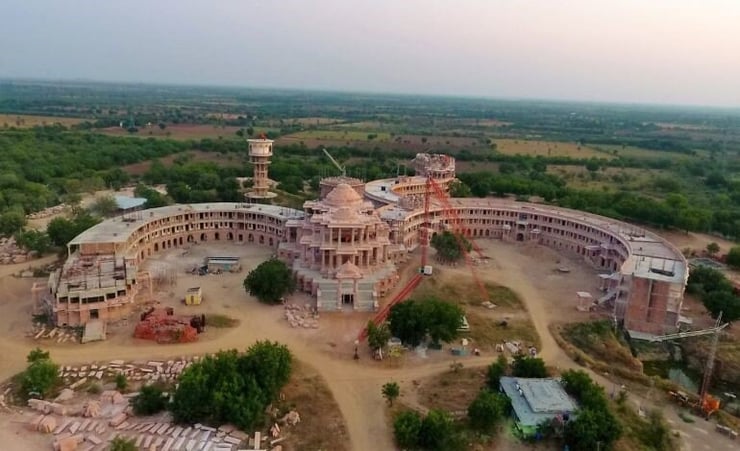Hindu mantra set in stone aims for world heritage status

OM Ashram, currently under construction in the Indian state of Rajasthan, aims to be " the world's largest man-made symbol of OM."
According to a booklet about Paramhans Swami Maheshwarananda, a Rajasthan - based yoga guru and the moving spirit behind the project, the structure has the shape of OM , the primary symbol of Hinduism.
The developers hope the OM Ashram will be declared a world heritage site.
When it is completed, the ashram will have 108 residential units symbolising the 108 units of the Japa Mala, according to the ashram website.
“Current planning is for the work to be completed so that opening ceremonies can be held this year between September and November. The dates are not yet finalised but work is proceeding day and night,” said David Jenkins, Wellington-based Treasurer of Yoga in Daily Life, a system of yoga promoted by Swami Maheshwarananda with a network of centres worldwide.
Om Ashram is one of many projects initiated by Gurudev [as Swami Maheshwarananda is known to his followers], who founded the Yoga in Daily life Society in New Zealand and 30 other countries. The swami is based in Vienna, Austria, but travels to India frequently.
Jenkins says the guru has “tirelessly circled the globe over the last 50 years spreading the teachings of the Sri Alakhapuriji Siddhapeeth Parampara (lineage).”
The NZ Yoga in Daily Life Society is a not-for-profit volunteer community organisation and is affiliated with the International Fellowship of Yoga in Daily Life, which operates globally.
Yoga in daily life has centres in the Wellington and Auckland regions. Its president is Swami Madhuram Puri who is based in Kapiti, Wellington.Naginbhai Patel is the vice-president.
The Wellington centre was established in March 1993 following the guru’s first visit to NZ in 1992. It started as the New Zealand-Indian Yoga Vedanta Society International, which was later renamed as the Yoga in Daily Life Society.
Activities include weekly classes catered to varying age groups and levels of experience. There is also a weekly Satsang or spiritual congregation, along with a monthly “full moon” meditation session. These programmes are supported by workshops on vegetarian cooking, yogic breathing techniques and music concerts promoting meditation. The centre also offers weekend retreats twice a year.
Swami Maheshwarananda conducts in-person classes in New Zealand once or twice a year.
The swami was invited to speak at a Peace Seminar held in the old legislative chamber of the NZ Parliament on 6 March 2019.
There are about seven teachers engaged in centres across New Zealand. Apart from Jenkins, the Wellington faculty includes yoga teacher Seva Devi, originally from the Czech Republic.
“Our timetable consists of drop-in classes as well as courses. The drop-in classes have a varying number of students. The courses are focused on teaching the Yoga in Daily Life system which Swamiji established back in Europe nearly 50 years ago. We have eight levels. The courses are [structured] over six, nine or 12 weeks,” Devi points out.
Devi was introduced to Swami Maheshwarananda by her sister who manages the Yoga in Daily Life ashram in Auckland. In 2010, Devi accompanied the swami and his disciples to Hardwar in India to attend the Kumbh Mela [a mass Hindu pilgrimage].
It was a pilgrimage that changed her life.
“It was at that time that I decided to follow and learn from this Swamiji [Swami Maheshwarananda],” Devi recalls.
So, how does Yoga in Daily Life differ from other yoga schools?
“We like to think that this [Yoga in Daily Life] is taught from an authentic, ancient [Indian] tradition but informed by the needs of the modern world,” Jenkins notes.





